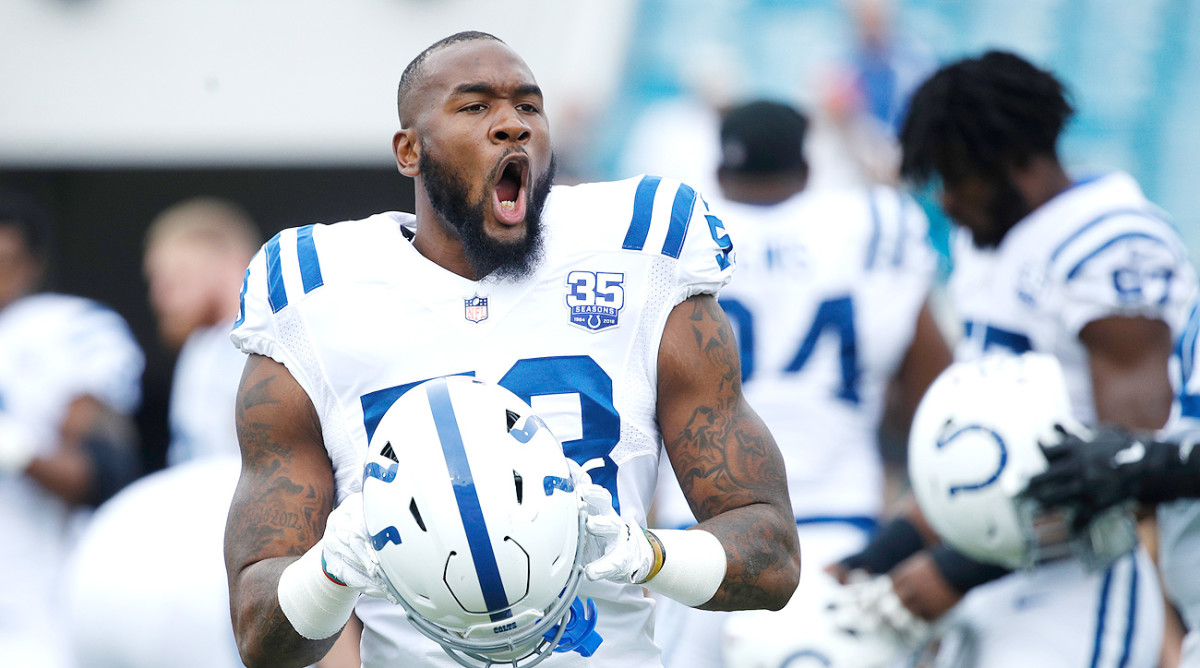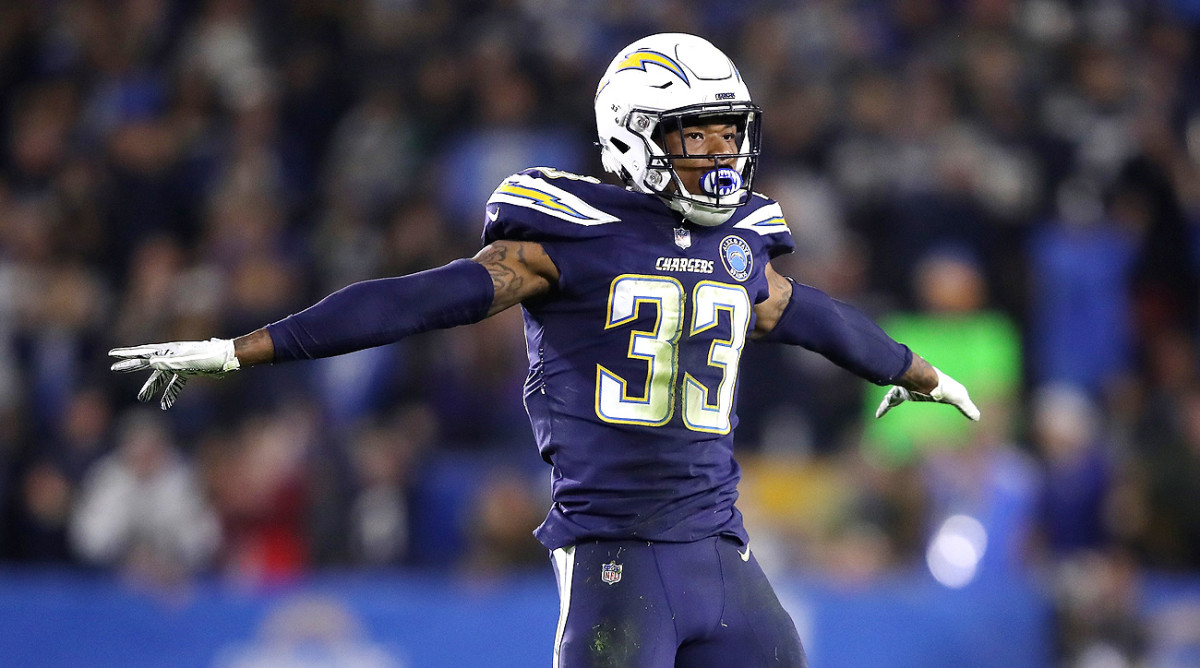An Introductory Primer to IDP Leagues

The rhythm of the summer has become familiar to everyone in the fantasy football community, which may leave you wanting some variety. There’s no better way to diversify your fantasy football profile than by joining an individual defensive player, or IDP, league. If you are new to IDP leagues, this primer will highlight some pointers you’ll want to factor into your equations before building your final draft board. Even if you have drafted linebackers and cornerbacks in your time, it never hurts to cram in that little bit of extra prep. As the old adage goes, if you fail to prepare, you’re preparing to fail.
As is the case with any fantasy league to be honest, you need to be on top of your scoring system and how it affects player values. If you take anything from this article I hope that it is that the single most important thing you can do before any fantasy season is to familiarize yourself with the league’s scoring system. It should be the first thing you do whenever you join any fantasy league as it impacts every player’s value and scoring potential.
Once you’ve got a firm grasp on how the league’s scoring works, the next step in preparing for an IDP league is to get a firm handle on player types at each position.

Defensive Linemen
Defensive fronts bring a diverse set of players. There are 3-4 guys, 4-3 guys, run stoppers and double-digit sack artists, not to mention rotational rushers and situational players. More often than not, your focus should be on 4-3 guys with double-digit sack potential who will play upwards of 65% of snaps. Generally speaking, 4-3 ends are more volatile scorers than their 3-4 counterparts because they have less reliance on tackle totals for their scoring. In big-play leagues, this works in their favor because when they do record multi-sack games they can be difference makers. In tackle-heavy formats, however, the 3-4 ends who can break 50 total tackles in a season can push up well into the DL2 tier.
Don’t sleep on rotational guys as high upside backups, especially in big-play scoring leagues. Mario Addison springs to mind as a player who seems to have made a career in a limited snap-count role for Carolina, posting five mult-sack games and 29.5 sacks over the last three years. Rookies also can often find themselves in these situational roles, especially those not drafted in the first round, and can parlay those early season snaps into significant time by the end of the season (Patriots rookie DE Chase Winovich anyone?).

Linebackers
At linebacker, just like at defensive end, one of the key things to know is the base scheme of every defense. This is key because a 3-4 outside linebacker is a pass rusher in the same vein as a 4-3 defensive end, with the primary responsibility to disrupt the opposing quarterback. In most fantasy league setups, pass-rushing 3-4 OLBs like Khalil Mack and Von Miller are hugely devalued compared with linebackers who play in the middle. The exception is, unsurprisingly, big-play scoring leagues, as their 15-sack upside can propel them into the LB2 tier. Their scoring, however, can be inconsistent from week to week, something I’d advise you to avoid when drafting IDPs.
When it comes to ranking the fantasy value of the different linebacker positions, I would break them down as follows:
4-3 MLB > 3-4 ILB and 4-3 WLB >> 4-3 SLB >>> 3-4 OLB
Ideally, you’re targeting 4-3 middle linebackers, who marginally top 3-4 inside linebackers and 4-3 weak-side backers. These three positions are traditionally the team’s three-down linebackers, which is itself a very important designation, and a key indicator of fantasy value. Linebackers asked to man the middle, inside and weakside tend to accumulate higher tackle totals, as their on-field responsibilities tend towards stopping the run. When they assume three-down or every-down roles on the defense they can break 100 total tackles.
In all but the deepest IDP leagues, I’d recommend scrubbing all 3-4 outside linebackers and 4-3 strong-side linebackers from your draft board, and even go as far to only focus on three-down linebackers. This strategy gives your roster a high-floor scoring engine each week and allows you to be more aggressive in the draft or selecting your offensive starters that week.
Follow the link for Ross' definitive guide to dominating your IDP league draft.
Going one step further in the pursuit of the next breakout fantasy linebacker rather than simply selecting Luke Kuechly or Bobby Wagner, look for players that show dynamic playmaking ability and have flashed big-play potential in more than one way. Being a 120-tackle guy who can add in a few sacks is great, but players who have shown a tendency to force a fumble, as well, or have shown ability in coverage can score fantasy points in such a variety of ways that it’s hard for an opposing team to scheme them out of a game. For example, Kiko Alonso had three interceptions and three forced fumbles last year, enough to push him into the LB1 tier despite only recording 79 solo tackles.

Defensive Backs
At defensive back, it is the run stuffers who are the most highly-prized players, even in big-play scoring leagues. Being able to consistently produce high-tackle numbers year after year makes them dependable and desirable (the same goes for Tampa-2 coverage corners asked to support the run), whereas roaming free safeties are reliant on takeaways, and cover cornerbacks need to be targeted regularly.
Traditionally, defensive backs that blitz often can have elite fantasy values, with future Hall of Famer Charles Woodson famously being one of the most memorable examples of such a stereotype. Last season saw rookie Derwin James utilized aggressively in the box and on blitzes, which earned him a DB1 valuation, as well as All-Pro and Pro Bowl honors in his first season. He subsequently earned a unanimous No.1 rank from us in 4for4's defensive back rankings for 2019.
However, that hasn’t been quite the case in recent seasons for safeties in general, with many teams using more nickel formations to counter the leaguewide shift to a pass-first game. By employing more nickel defense in reaction to three-wide sets on offense, as well as pass-catching tight ends such as Travis Kelce and George Kittle, there has been an evolution in the types of player used in varying defensive back roles.
There are slot corners, such as Chris Harris Jr. and Desmond King, who will be tasked with manning up elite receivers and asked to move inside. This type of corner, if blessed with ball-hawking skills, can be among of the best fantasy corners in IDP leagues. They are also some of the hardest players to identify preemptively, so you might be better served using the far simpler ‘rookie corner rule’ in finding your fantasy defense’s corners. If a rookie corner is deployed as a starter, they often have significant fantasy value given that opposing teams will look to target them as much as possible. The more opportunity a players score points, the more points he will score.
The nickel corner/dime linebacker types, players like Landon Collins and Kam Chancellor, are some of the most valuable fantasy defensive backs in IDP formats. More often than not, they are categorized as safeties. These players are happy taking on ball carriers near the line of scrimmage and are big enough to do so, but also have a skill set that allows them to cover those athletic tight ends that split the field. Because of their blend of size and skill set, they are a rare breed, but worth their weight in fantasy gold.
Usage at linebacker or in sub-packages can add value to a defensive back’s bottom line. In recent seasons, we have seen the Cardinals install Deone Bucannon as an inside linebacker for the majority of the season, and the Rams plug in Mark Barron on the weak side after Alec Ogletree suffered a season-ending injury. The net result was that both players were top-10 options on all sites that classified them as defensive backs. Keep a close eye on how teams are using their safeties during the preseason, and also how sites are designating them.
Stat Crews
Once you’ve got a handle on player types and scoring systems, you can take another step toward winning your league by knowing about the variance in home stat crews as it pertains to awarding tackles. The NFL does not define a tackle as an official statistic, so home stat crews award tackles based on a somewhat ambiguous definition, and the result is that some players rack up assisted tackles at a much higher rate than others, while other stat crews are freer with their awarding of solo tackles.
Based on the last few years of data, the most IDP-friendly home stat crews belong to the Giants, Bills and Chargers. Defensive players on those teams get a slight boost in value, as will all visiting players who play games in those stadiums. Stat crews to be slightly wary of include those belonging to the Jets, Vikings and Dolphins.
Don’t fret about owning multiple defensive players from one team either. The stack has become a strategy du jour in DFS games, and it’s not something that I’d get concerned with avoiding on fantasy draft day in IDP formats. For example, I won’t be worried if I ended up owning the Chargers trio of Joey Bosa, Melvin Ingram and Derwin James, especially as their home stat crew is a favorable one. I’d also be happy enough in owning the Atlanta trio of Vic Beasley, Deion Jones and Keanu Neal.
